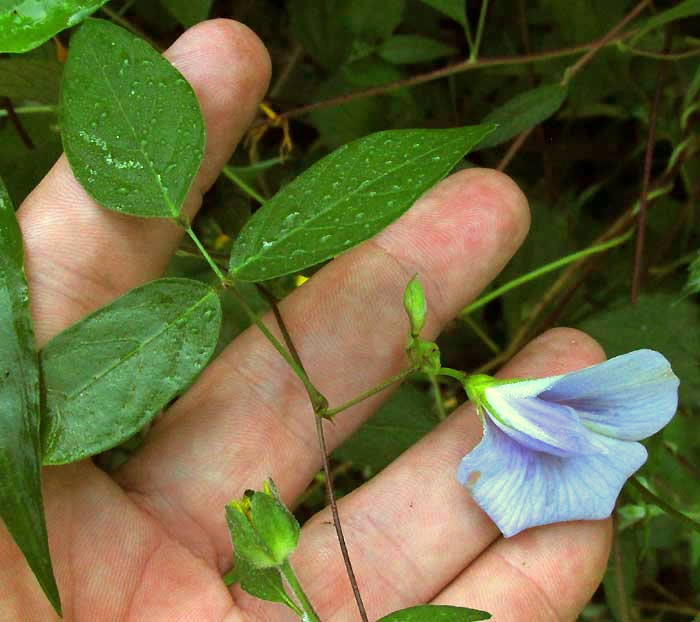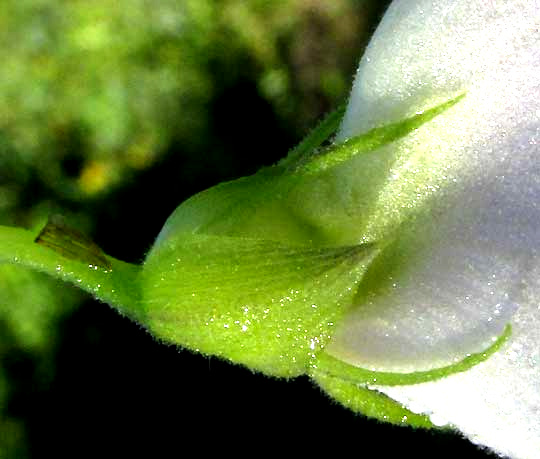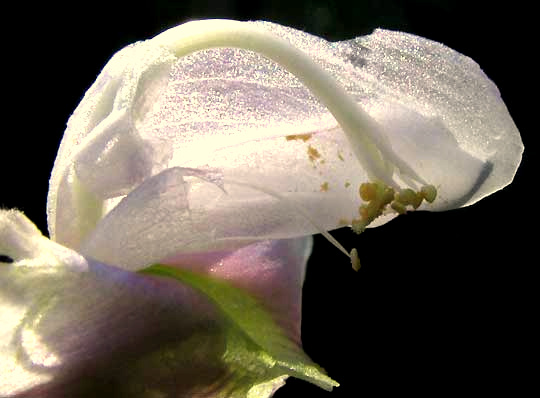Excerpts from Jim Conrad's
Naturalist Newsletter

from the November 8, 2015 Newsletter issued from Hacienda Chichen Resort beside Chichén Itzá Ruins, central Yucatán, MÉXICO
SPURRED BUTTERFLY PEA
In this area during much of the rainy season/summer, along roads and other open places, frequently there's a vine with leaves divided into three leaflets and bearing large flowers structured like typical Bean Family blossoms, except that they're upside-down. It's the Butterfly Pea, shown at www.backyardnature.net/yucatan/butt-pea.htm.
I haven't seen that species in blossom for awhile, but nowadays a very similar vine is blossoming, also with leaves consisting of three leaflets and bearing upside-down Bean-Family-type flowers, as shown at the top of this page.
Comparing the two vines we get to enjoy two "variations on the butterfly pea theme," for this is a second butterfly pea species. This later-flowering one is smaller and more delicate that the other. It's the Spurred Butterfly Pea, CENTROSEMA VIRGINIANUM. Centrosema species sometimes are distinguished by the shape of their sepals and the bract below the calyx, so a photo showing that is provided below:

You can see from the species name virginianum that this species also occurs in the US. In fact, I knew it well during my early botanizing days. It's distributed widely from the eastern US south through Mexico and Central America to Argentina in South America, plus the Caribbean islands, and it's been introduced in tropical West Africa.
You might wonder why a genus would turn its flowers upside-down -- and if you need a review of how a right-side-up bean flower presents itself, look at the Kudzu flower at www.backyardnature.net/fl_beans.htm.
If you remove one side of our present butterfly pea flower's top "hump," it'll start to make sense. What's inside our flower's hump is shown below:

Imagine a pollinator landing on the large flat surface below the hump -- the "landing pad." Dark lines on the landing pad converge toward a pale area beneath the hump, so the pollinator is drawn there. As the pollinator forces its way under the hump, the stamens with their filaments fused into an arching cylinder shove their anthers down to dust pollen onto the pollinator's back. Therefore, it's all designed to facilitate pollination.
Moreover, in that picture, notice the small, pale stigma extending just beyond the stamens' anthers. It's positioned to be the first sexual part touched by a visiting pollinator, to receive pollen from other flowers before the stamens bestow their own pollen, to be carried to another blossom
So, one advantage of butterfly pea flowers being upside-down is that the large petal known as the "keel" or "standard," which usually just rises at a blossom's top, in this upside-down condition forms a fine landing pad.
Also in the hump picture, notice that one stamen stands apart from the others, whose filaments are joined into an arched cylinder surrounding the style. In the Bean Family very often you meet this configuration of 9 + 1 stamens. Such stamens are said to be "diadelphous." I'm unsure what the advantage to having diadelphous stamens might be, unless it's simply to provide a second opportunity for a visiting pollinator to be doused with pollen. Interestingly, most Bean Family members with flowers all grouped into a single cluster with no outlying members are mostly pollinated by organisms visiting to eat pollen, while blossoms attracting pollinators searching for nectar normally produce diadelphous stamens.